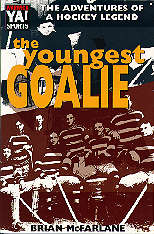

 |
The Youngest Goalie.
Brian McFarlane. Subject Headings:
Grades 4 - 9 / Ages 9 - 14.
** /4
|

excerpt:
The Nuggets' dressing room was quiet, too quiet. Skates, pads and jerseys were donned in silence. It's as if we're all going out to face a firing squad, thought Albert. Maybe we are. What we need is someone to pep us up, to inspire us. Weldy would do it but he's not here. What a shame he didn't arrive in time.Well-known sports commentator and author, Brian McFarlane attempts to breathe life into the person behind a potential "Trivial Pursuit" question: "Who was the youngest goalie ever to play in the Stanley Cup finals?" The answer resides in hockey's early history when the players were amateurs and teams could challenge for the Cup. In 1904, Albert Forrest was just 17 when he travelled some 4,000 miles from the Yukon with his team, the Dawson City Nuggets, to play the Ottawa Silver Seven in a best of three series. Although the Nuggets were beaten in two straight games, with the second ending 23-2 in Ottawa's favour, Albert was nevertheless selected as his team's most valuable player. Young readers might wonder if the series outcome would have been different had the Silver Seven let their opponents regain their skating legs following their long journey.When Albert tried to encourage his teammates by saying, "C'mon fellows, we can do it. Let's take it to them. Let's win tonite," most of the players stared at the floor, deep in their own thoughts. So Albert sat back and said no more.
In this piece of biographical fiction, McFarlane follows Albert Forrest from 1898, when his parents moved from Quebec to seek gold in the Yukon, until his 1904 return to Dawson City after the hockey series. McFarlane's writing exposes today's airplane-wise children to the Forrests' turn-of-the-century demanding and dangerous journey which required them to travel by rail, ship, on foot and by small boat before reaching their final destination. McFarlane sketches Albert's growing-up years in Dawson prior to his being asked to join the Nuggets as their goalie, but it is when McFarlane's is describing the hockey action that his writing becomes the most lively and engaging. The amount of direct conversation in the book underlines its fictional nature, and, despite McFarlane's attempts to make Albert a three dimensional character via the use of recreated thoughts and speech, Albert remains "thin" and somewhat distant from readers. For those who have become attached to Albert, however, an epilogue entitled "The Rest of the Story" briefly outlines what happened to Albert, plus some of the book's other characters, in the years that followed.
While the "Preface" states that The Youngest Goalie "is based on truth," the epilogue adds that "some of the episodes depicted by the author are purely fictional." Unfortunately, McFarlane never identifies the degree to which he has enhanced reality nor does he reveal the source material he drew upon to create the book. Additionally, the volume suffers from a embarrassing surfeit of annoying typographical errors, including word and sentence breaks, which become increasingly distracting.
Recommended with reservations.
Dave Jenkinson is a hockey fan who also happens to teach children's and YA literature courses in the Faculty of Education at the University of Manitoba.

To comment on this title or this review, send mail to cm@umanitoba.ca.
Copyright © 1998 the Manitoba Library Association.
Reproduction for personal use is permitted only if this copyright notice
is maintained. Any other reproduction is prohibited without
permission.
Published by
TABLE OF CONTENTS FOR THIS ISSUE - JUNE 19, 1998.
AUTHORS |
TITLES |
MEDIA REVIEWS |
BACK ISSUES |
SEARCH |
ORDER |
CMARCHIVE |
HOME
The Manitoba Library Association
ISSN 1201-9364